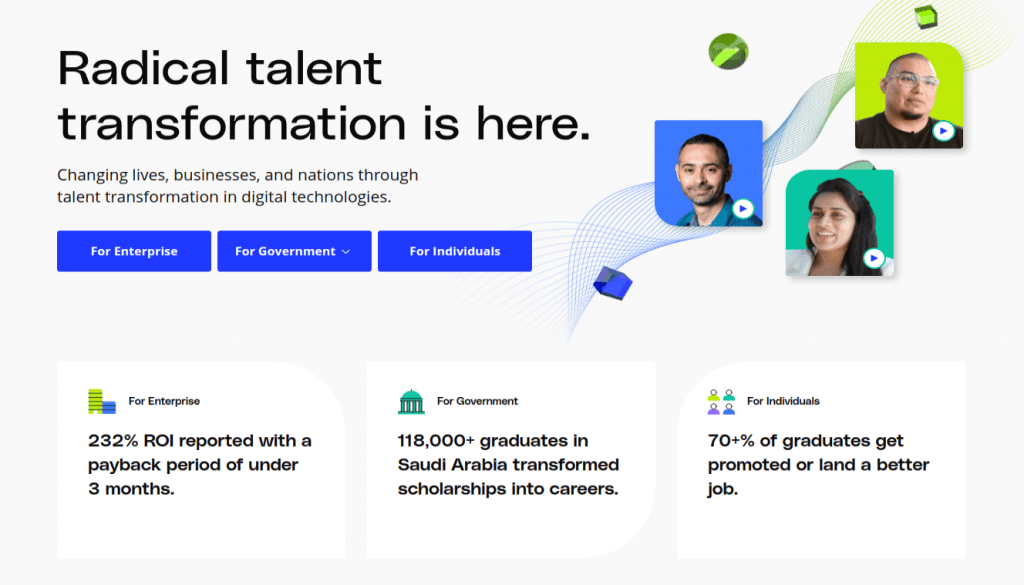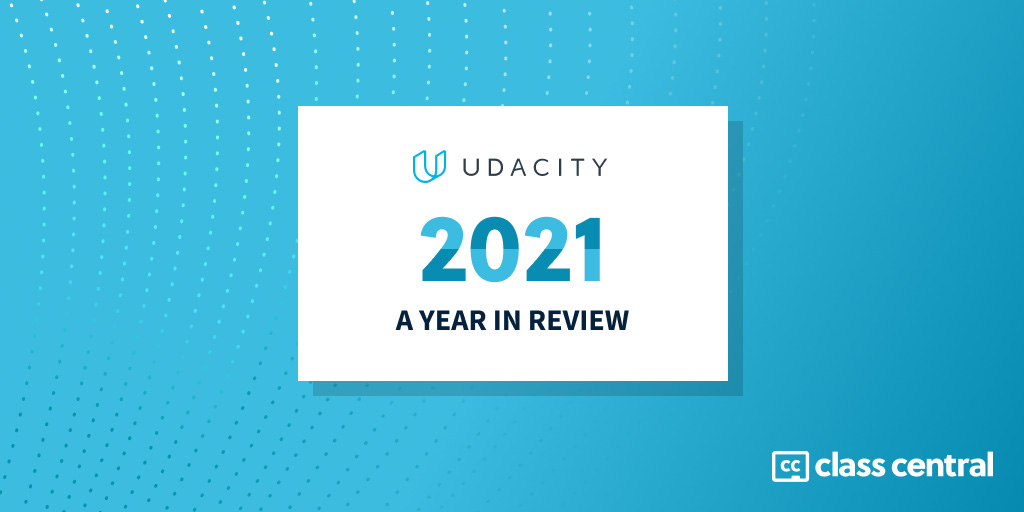Udacity’s 2021: Year in Review
In 2021, Udacity consolidated its enterprise focus, launched fewer free courses, but tripled scholarships.
In 2021, Udacity consolidated its position as a now largely enterprise-facing company whose focus is on corporations and governments rather than learners like you and me.
The refocus, initiated last year, comes in the wake of a few tumultuous years at Udacity. In 2018, they faced a downturn that prompted the CEO’s exit. In 2019, they carried out a restructuring plan punctuated by large layoffs. In 2020, amid a pandemic and under new leadership, they doubled down on B2B. And in 2021, they’ve settled in this position.

In the process, Udacity stopped making waves. Last year, we wrote five articles about the company. This year, by contrast, this article will be the first and last. And it’s not because we stopped paying attention. At Class Central, we’ve completed a bunch of Nanodegrees. Udacity has been on our mind. But Udacity’s mind isn’t on their consumer segment anymore.
For Class Central’s complete analysis of Udacity’s 2021, keep reading. For previous years’ analyses, follow the links:
- Udacity’s 2020: Year in Review
- Udacity’s 2019: Year in Review
- Udacity’s 2018: Year in Review
- Udacity’s 2017: Year in Review
- Udacity’s 2016: Year in Review
By the Numbers
| 2017 | 2018 | 2019 | 2020 | 2021 | |
| Nanodegrees | 22 | 35 | 40 | 59 | 75 |
| Graduates | 18K | 65K | 100K | 150K | NA |
| Revenue | 70M | 90M | NA | NA | NA |
| Employees | 500 | 350 | 300 | 400 | NA |
As Udacity’s focus turned away from consumers and toward business, the company also became less transparent. Most notably, Udacity stopped sharing clear growth numbers.
At Class Central, most of our analyses are based on data we’ve curated ourselves, either by hand or through web scraping. But when a figure can’t be inferred from data available online, we may ask companies directly — for instance, to prepare our end-of-year series. This year, our email to Udacity remained unanswered, hence the largely empty 2021 column above.
Nanodegrees
| 2018 | 2019 | 2020 | 2021 |
| 9 | 14 | 19 | 16 |
One of the salient measures of Udacity’s all-encompassing plan for putting the company back on track to profitability was to speed up Nanodegree rollouts. In 2018, they launched just 9 Nanodegrees. Since then, they’ve launched on average 16 each year. More specifically, in 2021, Udacity launched 15 Nanodegrees and 1 Executive Program. Below is the complete list.
- Java Programming Nanodegree (Jan)
- Security Analyst Nanodegree (Jan)
- Security Engineer Nanodegree (Feb)
- Full Stack JavaScript Developer Nanodegree (Mar)
- Ethical Hacker Nanodegree (Mar)
- Data Analysis and Visualization with Power BI Nanodegree (Mar)
- Cloud Computing for Business Leaders Executive Program (Apr)
- Cloud Native Application Architecture Nanodegree (May)
- Machine Learning DevOps Engineer Nanodegree (Jul)
- Security Architect Nanodegree (Sep)
- Enterprise Security Nanodegree (Sep)
- Digital Freelancer Nanodegree (Sep)
- Growth Product Manager Nanodegree (Oct — early access in 2020)
- Cloud Architect Using Microsoft Azure Nanodegree (Oct)
- AI Engineer Using Microsoft Azure Nanodegree (Nov)
- Site Reliability Engineer Nanodegree (Dec)
In addition, Udacity refreshed two of their best-selling Nanodegrees:
Note that as Udacity’s offering has kept growing, it’s become increasingly specific (and their names, increasingly long), often targeting particular tools and vendors rather than broad topics. For instance, there used to be just one machine learning Nanodegree; now, there are five:
- AWS Machine Learning Nanodegree
- Machine Learning DevOps Engineer Nanodegree
- Intro to Machine Learning with Pytorch Nanodegree
- Intro to Machine Learning with TensorFlow Nanodegree
- Machine Learning Engineer for Microsoft Azure Nanodegree
Free Courses
| 2013 | 2014 | 2015 | 2016 | 2017 | 2018 | 2019 | 2020 | 2021 |
| 12 | 31 | 64 | 49 | 34 | 35 | 7 | 5 | 3 |
Another consequence of the belt-tightening at Udacity has been the gradual decrease of the number of free courses launched each year. In 2021, Udacity released just three free courses:
- AI Fundamentals with Azure
- Intro to Machine Learning using Microsoft Azure
- Cloud Native Fundamentals
Scholarships
| 2019 | 2020 | 2021 | |
| Scholarships | 4 | 5 | 9 |
| Nanodegrees | 2850 | 3725 | 9877 |
For individual learners, perhaps a silver lining of Udacity’s closer dealings with companies is that it seems to have attracted more scholarship partners. In 2021, Udacity launched 9 scholarships, funding close to 10K Nanodegree programs, almost three times more than in 2020.
| Scholarship | Partner | Nanodegrees funded |
| Accenture Scholarship | Accenture | 600 |
| AWS AI & ML Scholarship | AWS | 2500 |
| Tech Scholarship | Bertelsmann | 1600 |
| OneTen Scholarship | OneTen | 2000 |
| AWS ML Scholarship | AWS | 425 |
| SUSE Cloud Scholarship | SUSE | 300 |
| Blacks in Tech Scholarship | Blacks in Tech | 150 |
| Advance Africa Scholarship | Access Bank | 2000 |
| Nokia Scholarship | Nokia | 302 |
Tags








AKSHAY VIKHE
Glad to see nanodegrees enrolments increased in 2021. Also I’ve got some positive feedback from the graduates about the quality of content and projects. ( here’s a review by Alice https://onlinecourseing.com/udacity-nanodegree-review/)
But in the process of increasing their nanodegrees, many graduates have complained about outdated content (eg.android basics nanodegree has the same content from past 3-4 years)
Some graduates are also struggling to find jobs after completing the nanodegree. But overall Udacity has a good rating among the community,